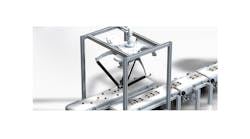Companion story to Robots Master Manufacturing's Complexities
A typical layout might include parallel incoming and outgoing conveyor belts carrying product to and from a robotic process. A Delta robot may be installed at one end of the process conveyor area, and a SCARA (selective compliant articulated robot arm) robot at the other end.
The incoming conveyor belt transports unsorted material. Material is then picked quickly and accurately by the Delta robot and placed in predefined patterns at the desired location on the outgoing conveyor. The deposit pattern is sorted by the SCARA robot.
When the predetermined pattern is completely filled, the Delta robot runs a standard deposit cycle or robot path with the corresponding pick-and-place velocity, rotating and transferring pieces from belt two to belt one in a mirror image of the original or other predetermined pattern.
Simultaneously, the SCARA robot begins filling the next deposit pattern.
A range of products and systems are available to handle this complex task. In the simple example depicted here, the controller is designed to handle process and motion control applications. It coordinates the Delta and the SCARA in real-time and in parallel, converting the Cartesian coordinates of the trajectories into the angular positions of the robots’ individual motion axes. The integrated control architecture significantly reduces the number of required components and simplifies intra-system communication.
The I/O system attaches directly to the controller via a common, fast backplane bus communicating with the six movement axes of the robots — all multi-axis servo inverters with integrated safety functions. Servo motors provide the dynamics and precision required in the execution of movements in combination with absolute value encoders for the delta robot and resolvers for the SCARA robot.
Two inverter drives connected to the controller via EtherCAT supply the asynchronous motors for the conveyor belts. All drives rely on the same DC bus, thereby requiring just one power supply unit or one brake chopper.
In this system example, the controller acts as a hardware platform for the process and the motion control. The I/O-system 1000 modules are integrated through a shared fast backplane bus. Multiple drive packages are in operation. These are compact drives comprising an inverter, 3-phase AC motor and gearbox. Visualization devices operate the machine modules. One of these, communicating with the visualization and command stations of the machine via Ethernet, can function as the hardware platform for visualization and the camera evaluation involved in parts detection.



